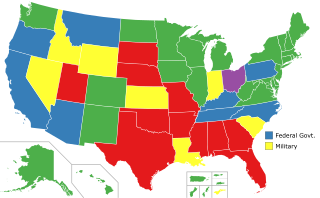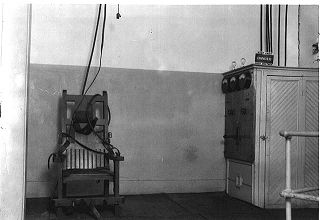
Lethal injection is the practice of injecting one or more drugs into a person for the express purpose of causing rapid death. The main application for this procedure is capital punishment, but the term may also be applied in a broader sense to include euthanasia and other forms of suicide. The drugs cause the person to become unconscious, stops their breathing, and causes a heart arrhythmia, in that order.

The electric chair is a specialized device employed for carrying out capital punishment through the process of electrocution. During its use, the individual sentenced to death is securely strapped to a specially designed wooden chair and electrocuted via strategically positioned electrodes affixed to the head and leg. This method of execution was conceptualized by Alfred P. Southwick, a dentist based in Buffalo, New York, in 1881. Over the following decade, this execution technique was developed further, aiming to provide a more humane alternative to the conventional forms of execution, particularly hanging. The electric chair was first utilized in 1890 and subsequently became known as a symbol of this method of execution.

In the United States, capital punishment is a legal penalty throughout the country at the federal level, in 27 states, and in American Samoa. It is also a legal penalty for some military offenses. Capital punishment has been abolished in 23 states and in the federal capital, Washington, D.C. It is usually applied for only the most serious crimes, such as aggravated murder. Although it is a legal penalty in 27 states, 20 states currently have the ability to execute death sentences, with the other seven, as well as the federal government, being subject to different types of moratoriums.
Capital punishment is a legal penalty in the U.S. state of Arkansas.

San Quentin Rehabilitation Center (SQ), formerly known as San Quentin State Prison, is a California Department of Corrections and Rehabilitation state prison for men, located north of San Francisco in the unincorporated place of San Quentin in Marin County.

Old Sparky is the nickname of the electric chairs in Arkansas, Connecticut, Florida, Georgia, Illinois, Kentucky, Nebraska, New York, Ohio, Oklahoma, South Carolina, Texas, Virginia, and West Virginia. Old Smokey was the nickname of the electric chairs used in New Jersey, Pennsylvania, and Tennessee. "Old Sparky" is sometimes used to refer to electric chairs in general, and not one of a specific state.
Arizona State Prison Complex – Florence also known as Florence State Prison (FSP) is a former facility operated by the Arizona Department of Corrections (ADC). The main FSP prison was located in Florence, Arizona. The Florence complex used to include a unit in Picacho in unincorporated Pinal County however, the Picacho Unit was closed and destroyed in early 2013. The Globe Unit in Globe is now part of ASPC-Phoenix.
Florida State Prison (FSP), otherwise known as Raiford Prison, is a correctional institution located in unincorporated Bradford County, Florida, with a Starke postal address. It was formerly known as the "Florida State Prison-East Unit" as it was originally part of Florida State Prison near Raiford. The facility, a part of the Florida Department of Corrections, is located on State Road 16 right across the border from Union County. The institution opened in 1961, even though construction was not completed until 1968. With a maximum population of over 1,400 inmates, FSP is one of the largest prisons in the state. FSP houses Florida's one of two male death row cell blocks and the State of Florida execution chamber. Union Correctional Institution also houses male death row inmates while Lowell Annex houses female death row inmates.

Mark Dean Schwab was an American murderer and child rapist. He was convicted of the April 18, 1991, rape and murder of 11-year-old Junny Rios-Martinez Jr. and imprisoned at Raiford Prison in Florida. Schwab was convicted of the crime in 1992 and sentenced to death by lethal injection. In addition, he received two life sentences. His execution was the first in Florida after executions were temporarily halted following the botched lethal injection of Ángel Nieves Díaz.

Ángel Nieves Díaz was a Puerto Rican convict and a suspected serial killer who was executed by lethal injection by Florida. Nieves, who had escaped from a prison in Puerto Rico while serving time for murder, was convicted of shooting and killing the manager of a strip club in Florida in 1979. He maintained his innocence until his death.
Death row, also known as condemned row, is a place in a prison that houses inmates awaiting execution after being convicted of a capital crime and sentenced to death. The term is also used figuratively to describe the state of awaiting execution, even in places where no special facility or separate unit for condemned inmates exists. In the United States, after an individual is found guilty of a capital offense in states where execution is a legal penalty, the judge will give the jury the option of imposing a death sentence or life imprisonment without the possibility of parole. It is then up to the jury to decide whether to give the death sentence; this usually has to be a unanimous decision. If the jury agrees on death, the defendant will remain on death row during appeal and habeas corpus procedures, which may continue for several decades.

Capital punishment is a legal penalty in the U.S. state of Florida.

Gary Ray Bowles was an American serial killer who was executed in 2019 for the murders of six men in 1994. He is sometimes referred to as The I-95 Killer since most of his victims lived close to the Interstate 95 highway.

Martin Edward Grossman was convicted of first degree murder for his part in the December 13, 1984, Florida killing of wildlife officer Peggy Park. He was executed by lethal injection. In the days before his execution, there were a large number of appeals for clemency, ranging from petitions to pleas, as well as a request to halt the execution from Pope Benedict XVI. Grossman, a Jewish American, received strong support from national and international Jewish organizations for his death sentence to be commuted.

Carey Dean Moore was a convicted murderer, executed by lethal injection by the state of Nebraska. It was the first execution in Nebraska using lethal injection, and the state's first execution since 1997. The execution was the first in the United States to use fentanyl.

Mark James Asay was an American spree killer who was executed by the state of Florida for the 1987 racially motivated murders of two men in Jacksonville, Florida. He was convicted, sentenced to death, and subsequently executed in 2017 at Florida State Prison by lethal injection. Asay's execution generated attention as it was noted by multiple news agencies that he was the first white person to be executed in Florida for killing a black person. He was also the first person to be executed in the United States using the drug etomidate.












